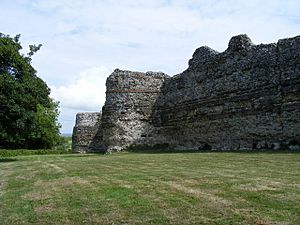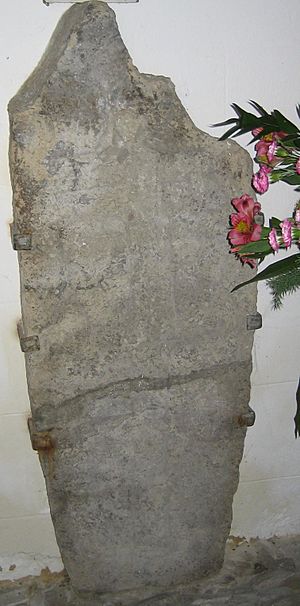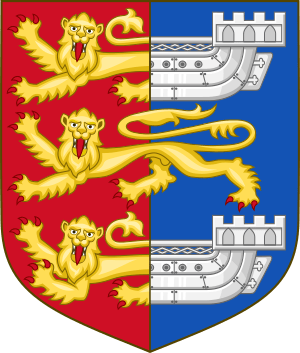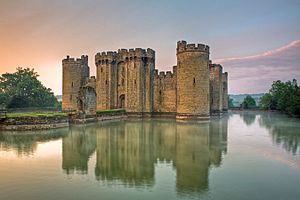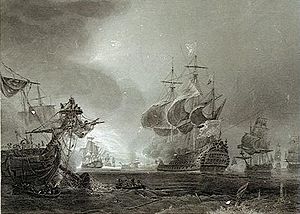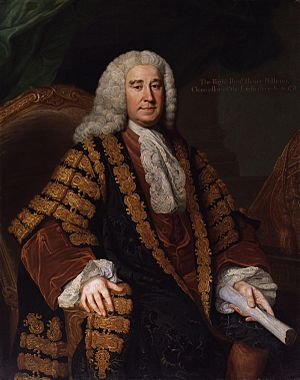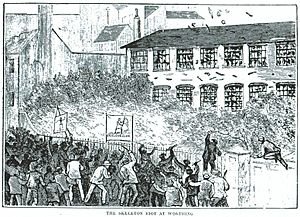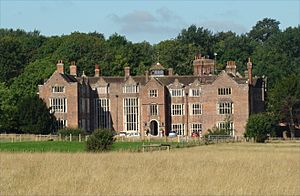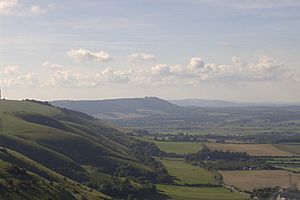Timeline of Sussex history facts for kids
This is a timeline of important events in the history of Sussex, a historic county in England. It covers many centuries, from ancient times when Romans lived here, all the way up to recent events. You can learn about kings, battles, big changes, and how Sussex became the place it is today.
Contents
Roman Times in Sussex
First Century: Roman Arrival
- Around 15 AD: Verica became king of the southern Atrebates, a local tribe. Their main town was near what is now Chichester.
- By 42 AD: Caratacus, a powerful king from another tribe, took over the Atrebates' land and forced Verica out.
- Around 43 AD: The Romans arrived on the Sussex coast. They might have come to help Verica. Under Roman rule, a friendly kingdom called Regni was created for Cogidubnus. This kingdom included much of what is now Sussex.
- Around 75 AD: The huge Fishbourne Roman Palace, the biggest Roman home north of the Alps, was built near Chichester Harbour.
- Around 80 AD: The Regni kingdom became a Roman area called a civitas, with its capital at Noviomagus Reginorum (modern Chichester).
Second Century: Growing Roman Influence
- 121/122 AD: A large stone statue, possibly the biggest in Roman Britain, was put up at what is now Chichester Harbour.
- Around 150 AD: Ptolemy's famous book Geography mentioned several places in what would become Sussex. These included Magnus Portus, Noeomagus (Chichester), Novus Portus, and the Flavius Trisantona (River Arun).
- Around 190 AD: Work began on a Roman villa, a large country house, called Bignor Roman Villa just north of the South Downs.
Third Century: Forts and Discoveries
- Around 200-250 AD: The Beachy Head Lady, the first known person of African origin in Britain, was buried at East Dean.
- Around 293-300 AD: The Romans built a strong fort called Anderitum at Pevensey. This was part of their Saxon Shore defense system.
Fifth Century: Romans Leave and Saxons Arrive
- Around 410 AD: The Romans left Britain, marking a big change for the area.
- 460s onwards: A collection of coins was buried at what is now Patching.
- Around 477 AD: Aelle arrived at Cymenshore. He later became the first king of Sussex and the first Bretwalda, a powerful ruler over other Anglo-Saxon kingdoms.
- 485 AD: The Battle of Mercredesburne took place.
- 491 AD: The Saxons laid siege to Anderitum (Pevensey).
Early English Kingdoms
Sixth Century: Kingdom of Sussex Begins
- Around 500 AD: The Heptarchy began, which was a period when England was divided into seven main Anglo-Saxon kingdoms. One of these was the Kingdom of Sussex.
Seventh Century: Christianity and Conflicts
- 607 AD: Ceolwulf of Wessex fought against the South Saxons.
- 661 AD: King Æthelwealh of Sussex became Christian. His kingdom grew to include the Meon Valley and the Isle of Wight.
- Around 679 AD: Sussex suffered from a famine.
- 681 AD: St Wilfrid arrived in Sussex and helped spread Christianity.
- Around 681 AD: Selsey Abbey was founded.
- 685-686 AD: Cædwalla of Wessex invaded Sussex and killed King Æthelwealh.
- 686 AD: The South Saxons attacked Hlothhere of Kent, the king of Kent, to support his nephew Eadric of Kent.
- Around 7th century: Sussex was mentioned in the Tribal Hidage, a list of Anglo-Saxon lands.
Eighth Century: More Changes and Battles
- Around 700 AD: Parts of Sussex were mentioned in the Ravenna Cosmography, including Chichester and Pevensey.
- 710 AD: King Nunna of Sussex and King Ine of Wessex fought against King Geraint of Dumnonia (from Devon and Cornwall).
- Around 715 AD: Eadberht of Selsey, the Abbot of Selsey, became the first bishop of the South Saxons.
- 771 AD: King Offa of Mercia defeated the Haestingas and added their land to the Kingdom of Sussex.
Ninth Century: Wessex Takes Over
- Around 827 AD: Sussex became part of the Kingdom of Wessex.
- 828 AD: The Historia Brittonum was written, mentioning a story where Sussex was given to the Saxons.
- 839 AD: Æthelstan of Wessex became "King of the Dwellers in Kent, of the East Saxons, of the South Saxons and of Surrey," under his father, Æthelwulf of Wessex.
- 858 AD: Æthelwulf of Wessex was buried at Steyning.
- 860 AD: Æthelberht of Wessex became king of Wessex. Sussex, along with other areas, became a full part of this kingdom.
- 885 AD: King Alfred met his biographer, Asser, for the first time at Alfred's royal estate in Dean, Sussex.
Tenth Century: Fortified Towns and Viking Raids
- After 915 AD: The Burghal Hidage listed five fortified towns (burhs) in Sussex: Chichester, Burpham, Lewes, Hastings, and Eorpeburnan.
- 927 AD: Æthelstan became the first king to call himself "King of the English."
- 930 AD: A Royal Council (Witenagemot) for all of England, including King Æthelstan, was held at Lyminster.
- 994 AD: Vikings, led by Olaf Tryggvason and Sweyn Forkbeard, attacked the coast of Sussex.
Medieval Sussex
Eleventh Century: Norman Conquest and New Beginnings
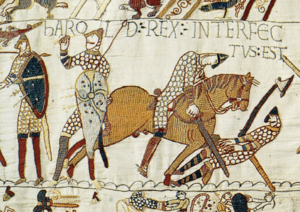
A scene from the Bayeux Tapestry showing King Harold's death at the Battle of Hastings
- 1011 AD: The last Viking raid on Sussex happened at Hastings. Later that year, the Danes ruled Sussex.
- 1049 AD: Sweyn Godwinson kidnapped his cousin Beorn at Bosham and later killed him.
- 1064 AD: Harold Godwinson sailed from Bosham to Normandy.
- 1066 AD, September: William of Normandy landed at Pevensey.
- 1066 AD, 14 October: The famous Battle of Hastings took place at Senlac Hill.
- 1075 AD: The Council of London decided that the bishop's seat for Sussex should move from Selsey Abbey to a new cathedral in Chichester.
- 1088 AD: During a rebellion, William II captured the rebel leader Odo of Bayeux after a six-week siege at Pevensey Castle.
- 1090 AD: The Church in the Wood Hollington, Saint Leonards on Sea, was first mentioned.
Twelfth Century: Cathedrals and Castles
- 1107 AD: Henry I of England allowed Bishop Ralph de Luffa to hold a fair in Chichester, which became known as the Sloe Fair.
- 1108 AD: Chichester Cathedral was officially opened under Bishop Ralph de Luffa.
- 1139 AD: The Siege of Arundel took place, part of a period of civil war called the Anarchy.
- 1155 AD: The earliest known document for the Cinque Ports was created. This group of coastal towns included Hastings, and later Rye, Winchelsea, and Seaford.
- 1187 AD: A fire destroyed Chichester Cathedral and much of Chichester city.
- 1194 AD: While Richard the Lionheart was held captive, King John's forces attacked Chichester Castle.
- 1199 AD: Chichester Cathedral was officially reopened under Bishop Seffrid II.
Thirteenth Century: Saint Richard and Big Battles
- 1208 AD: King John took Bramber Castle from the de Braose family, suspecting them of disloyalty.
- 1215 AD, 22 January: While King John visited Knepp Castle, powerful barons met in London to plan how to challenge the king.
- 1216 AD: During the First Barons' War, Rye and Winchelsea allowed Prince Louis of France to enter, hoping he would take the crown from King John.
- 1216 AD: Chichester Castle was attacked and taken over by Prince Louis of France.
- 1217 AD: A group of Wealdsmen led by William of Cassingham ambushed Prince Louis and his men at Lewes, chasing them to Winchelsea.
- 1225 AD: Chichester Castle was pulled down so that French forces could not use it again.
- 1250-1262 AD: The area of Chichester was created, the last of Sussex's six sub-divisions.
- 1262 AD: Pope Urban IV made St Richard of Chichester, a former bishop, a saint. He is now Sussex's patron saint.
- 1264 AD, 14 May: The Battle of Lewes took place.
- 1287 AD, February: Old Winchelsea was completely destroyed by a major flood.
Fourteenth Century: Famine, War, and Castles
- 1315 AD: The Great Famine of 1315–17 caused many deaths in Sussex and across Europe.
- 1336 AD: Edward III decided to locate the county court for Sussex in Chichester.
- 1338 AD: The Hundred Years' War began, and Hastings was burned down during naval attacks in the English Channel.
- 1348 AD: Over the next 20 years, the Black Death killed about half of Sussex's population.
- 1350 AD, 29 August: The Battle of Winchelsea took place.
- 1353 AD: Chichester was named the main trading port for Sussex in the Statute of the Staple.
- 1377 AD, 10 December: Bishop William Reade received permission to strengthen Amberley Castle.
- 1381 AD: During the Peasants' Revolt, people from Sussex joined riots in London, and Lewes Castle was attacked.
- 1385 AD: Work began on Bodiam Castle.
Fifteenth Century: Rebellions and Royal Prisoners
- 1406 AD: James I of Scotland was imprisoned in Pevensey Castle, where Henry IV of England arranged for his education.
- 1419 AD: Joan of Navarre, the Queen Mother, was imprisoned in Pevensey Castle for three years after Henry V accused her of witchcraft.
- 1450 AD, June: Rebels involved in Jack Cade's Rebellion gathered outside London.
- 1450 AD, 12 July: Jack Cade was fatally wounded at Cade Street.
- 1451 AD, Easter week: John and William Merfold were accused after publicly encouraging the killing of nobles and clergy, and calling for common people to rule.
Early Modern Sussex
Sixteenth Century: Religious Changes and Attacks
- 1504 AD: A law was passed to hold the court of the High Sheriff of Sussex alternately in Chichester and Lewes.
- 1538 AD, 20 December: The shrine of St Richard was destroyed following a royal order from Henry VIII.
- 1545 AD, 20 July: After the Battle of the Solent, the French Navy landed at Brighton and Newhaven but was pushed back.
- 1555-1557 AD: During the Marian Persecutions, many Protestants were killed for their faith, including 17 men burned alive in Lewes.
- Around 1562 AD: The first Huguenot community arrived at Rye, with more coming to Winchelsea the next year.
- 1588 AD, 1 October: Ralph Crockett and Edward James were executed in Chichester for being Catholic priests.
Seventeenth Century: Cricket and Civil War
- 1611 AD, 24 March: The first known record of adults playing cricket was in Sidlesham.
- 1611 AD: The emblem of Sussex was first used in John Speed's map book.
- 1624 AD, 10 September: Jasper Vinall became the first person recorded to have died from a cricket injury.
- 1642 AD, December: During the English Civil War, the Battle of Muster Green in Haywards Heath resulted in 200 Royalists being killed or fleeing.
- 1642 AD, 22–27 December: The English Civil War: Siege of Chichester took place.
- 1643 AD, 14 April - 1 May: The English Civil War: Siege of Arundel Castle occurred.
- 1643 AD, 13 December: The English Civil War: Battle of Bramber Bridge happened.
- 1643-1644 AD, 19 December 1643 - 6 January 1644: The English Civil War: Siege of Arundel took place.
- 1655 AD: George Fox preached at Ifield, leading to the first weekly Quaker meeting in Sussex. The first Quaker meeting house in Sussex was built there in 1676.
- 1690 AD, 10 July: The Battle of Beachy Head took place.
Eighteenth Century: Politics and Smuggling
- 1743 AD, 27 August: Henry Pelham, one of the MPs for Sussex, became Prime Minister of Great Britain.
- 1745 AD: The Sussex Weekly Advertiser newspaper was first published.
- 1748 AD, February: The brutal murders of William Galley and Daniel Chater by the Hawkhurst Gang of smugglers took place.
- 1749 AD, 16 January: Seven men were found guilty of smuggling and murder by the Hawkhurst Gang at a special court in Chichester.
- 1768 AD, 19 February: Thomas Paine moved to Lewes, where he developed his political ideas as part of the Headstrong Club.
- 1794 AD: The Sussex Yeomanry was formed when there was a threat of invasion during the Napoleonic Wars.
Modern Sussex
Nineteenth Century: Industry, Science, and Social Change
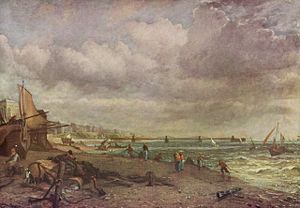
Brighton's Chain Pier, Sussex's earliest pier, was built in 1823. Painting by John Constable c.1824
- 1801 AD, 27 November: Prince Augustus Frederick became Duke of Sussex.
- 1804 AD, 3 June: Richard Cobden, a statesman and co-founder of the Anti-Corn Law League, was born.
- 1804 AD: The title 'Sussex' was transferred to the 35th (Royal Sussex) Regiment of Foot. This regiment was later replaced by the Royal Sussex Regiment in 1881.
- 1813 AD: The Ashburnham blast furnace closed, being the last in the Weald, as iron production moved north.
- 1822 AD: Gideon Mantell discovered dinosaur teeth in Tilgate Forest. He later named this new type of dinosaur 'iguanadon'.
- 1823 AD: Sussex's first pier, the Chain Pier, was built in Brighton.
- 1828 AD, 11 June: The Sussex County Hospital opened in Brighton.
- 1830 AD: The Captain Swing riots, where farm workers protested, took place across Sussex and England.
- 1832 AD: The Petworth Emigration Scheme was set up. Over five years, about 1,800 working-class people from Sussex moved to Upper Canada to escape poverty.
- 1836 AD, 27 December: The Lewes avalanche killed 8 people.
- 1837 AD, 27 March: Maria Fitzherbert, a long-time companion of the future King George IV of the United Kingdom, died at her home in Brighton.
- 1839 AD, 1 March: Sussex County Cricket Club was formed, becoming the first county cricket club.
- 1840 AD, 11 May: The first railway line in Sussex, from Brighton to Shoreham, opened.
- 1853 AD: Lewes Prison, the local prison for men in Sussex, opened.
- 1861 AD, 25 August: The Clayton Tunnel rail crash resulted in 23 deaths.
- 1865 AD: The County of Sussex Act 1865 confirmed that Sussex would be divided into East and West for administrative purposes.
- 1884 AD: The Skeleton Army riots occurred in Worthing.
- 1889 AD: County Councils were created for East and West Sussex.
- 1893 AD: An outbreak of typhoid fever in Worthing caused 188 deaths.
- 1894 AD: Administration of parts of Tunbridge Wells and Lamberhurst was moved to Kent County Council.
- 1896 AD: The National Trust acquired its first property, Alfriston Clergy House in Alfriston.
Twentieth Century: Wars, New Towns, and Culture
- 1907 AD: "Sussex by the Sea", the county song, was published for the first time.
- 1908 AD: G. A. Smith filmed A Visit to the Seaside in Brighton. This was the world's first commercially produced film in natural color.
- 1910 AD: An airfield was established at Shoreham Airport, making it one of the world's first airports.
- 1916 AD, 24 March: A German submarine mistakenly torpedoed the SS Sussex, a cross-channel ferry, resulting in 80 deaths.
- 1916 AD, 30 June: The Battle of the Boar's Head, known as "the Day Sussex Died," took place during World War I.
- 1918 AD, 13 October: At a meeting at Danny House in Hurstpierpoint, the Imperial War Cabinet agreed on the terms for the armistice to be offered to Germany at the end of World War I.
- 1925 AD: The Administration of Estates Act 1925 ended the custom of 'borough English', which was common in Sussex.
- 1926 AD, 11 May: Angry confrontations known as the Battle of Lewes Road took place in Brighton during the 1926 United Kingdom general strike.
- 1934 AD, 9 October: Fascists and anti-Fascists clashed at the Battle of South Street in Worthing.
- 1940 AD, September: Nazi Germany planned Operation Sea Lion to land on the Sussex coast and invade the UK.
- 1940 AD: German air raids on Sussex began, with those in Brighton known as the Brighton Blitz.
- 1942 AD: The Dieppe Raid was launched from Newhaven.
- 1943 AD: The deception plan Operation Fortitude was launched to trick the Nazis into thinking an invasion would come from Sussex and Kent.
- 1944 AD: The ports of Shoreham and Newhaven were used for the D-Day landings.
- 1945 AD, 8 May: VE Day marked the end of the war in Europe.
- 1945 AD, 15 August: VJ Day marked the end of World War II.
- 1946 AD, 7 September: Teddy Donaldson set a new world airspeed record of 615.78 mph in a Gloster Meteor over Littlehampton.
- 1946 AD: The New Towns Act 1946 named Crawley as the site for a new town.
- 1953 AD, 7 September: Neville Duke set a new world air speed record of 727.63 mph, flying a Hunter WB188.
- 1961 AD, August: The University of Sussex was granted its charter, becoming the first university in Sussex.
- 1962 AD: Chichester Festival Theatre opened.
- 1965 AD, 14 June: Bishop David Cashman became the first bishop of the Roman Catholic diocese of Arundel and Brighton.
- 1966 AD: The Sussex Downs Area of Outstanding Natural Beauty was created (later replaced by the South Downs National Park).
- 1967 AD: The first Brighton Festival and Brighton Fringe were held.
- 1967 AD: The first South of England Show was held at Ardingly.
- 1967 AD, 4 November: Iberia Flight 062 crashed into Blackdown, killing all 37 people on board.
- 1968 AD: Sussex Police was formed.
- 1970 AD: A team at the University of Sussex published the Sussex Manifesto for the United Nations.
- 1971 AD: Chichester Harbour Area of Outstanding Natural Beauty was set up.
- 1972 AD, July: The South Downs Way was established as Sussex's first National Trail and the UK's first long-distance bridleway.
- 1972 AD, October: Sussex Gay Liberation Front held a demonstration for gay rights, leading to the annual Brighton Pride event.
- 1974 AD: The Lord Lieutenancy of Sussex was replaced with separate ones for East and West Sussex.
- 1980 AD: Wilton Park was used for secret meetings between South African leaders, including Jacob Zuma.
- 1982 AD: At a meeting in Brighton, the International Whaling Commission voted for a ban on commercial whaling.
- 1983 AD, 22 October: BBC Radio Brighton was relaunched as BBC Radio Sussex.
- 1983 AD, 28 October: The High Weald Area of Outstanding Natural Beauty was confirmed.
- 1983 AD: The Sussex Border Path was created, a 222 km long path along Sussex's borders.
- 1984 AD, 12 October: The Brighton bombing was an assassination attempt on Prime Minister Margaret Thatcher.
Twenty-First Century: New Parks and Modern Events
- 2000 AD: Brighton and Hove was granted city status, becoming Sussex's second city.
- 2000 AD: Sir Charles Burrell, 10th Baronet began rewilding land at Knepp Wildland, the first lowland rewilding project in England.
- 2002 AD, 7 October: Piers Sellers became the first person from Sussex to travel into outer space.
- 2003 AD: Thousands of Chagossians settled in Crawley after being forced to leave their homes by the UK Government.
- 2005 AD, 5 December: The first civil partnership under the Civil Partnership Act 2004 took place in Worthing.
- 2007 AD, 16 June: Sussex Day, Sussex's county day, was celebrated for the first time.
- 2009 AD, 14 March: Finance ministers from the G20 met at South Lodge Hotel in Lower Beeding.
- 2011 AD, 1 April: The South Downs National Park became fully operational.
- 2011 AD, 20 May: The Flag of Sussex was officially registered.
- 2012 AD, 21 November: Katy Bourne was elected as the first Sussex Police and Crime Commissioner.
- 2013 AD, Summer: Protests against fracking took place in Balcombe.
- 2013 AD, 21 November: Beachy Head West, Kingmere, and Pagham Harbour became the first Marine Conservation Zones in Sussex waters.
- 2014 AD: UNESCO designated land between the Rivers Adur and Ouse as the Brighton and Lewes Downs Biosphere Reserve, Sussex's first UNESCO Biosphere Reserve.
- 2015 AD, 22 August: A military aircraft crashed onto the A27 during the Shoreham Airshow, killing 11 people.
- 2015 AD, 15 December: Timothy Peake became the first British European Space Agency astronaut and the first person from Sussex to board the International Space Station.
- 2016 AD, May: The South Downs National Park was granted International Dark Sky Reserve status to protect its night skies.
- 2016 AD, 23 June: The people of Sussex voted to leave the EU in the referendum on UK membership of the EU.
- 2018 AD: The Rampion Wind Farm, located off the Sussex coast, became operational.
- 2018 AD, 3 October: Prince Harry and Meghan Markle made their first official visit to Sussex as Duke and Duchess of Sussex.
- 2020 AD, 6 February: The first case of COVID-19 in Sussex was reported.
- 221 AD, March: DEFRA announced a new law to prevent trawling on 304 km2 of seabed off the Sussex coast, helping the rewilding and regeneration of the Sussex kelp forest.
See also
- History of Sussex
- Kingdom of Sussex
- Sussex in the High Middle Ages
- History of Christianity in Sussex
- History of local government in Sussex

All content from Kiddle encyclopedia articles (including the article images and facts) can be freely used under Attribution-ShareAlike license, unless stated otherwise. Cite this article:
Timeline of Sussex history Facts for Kids. Kiddle Encyclopedia.

